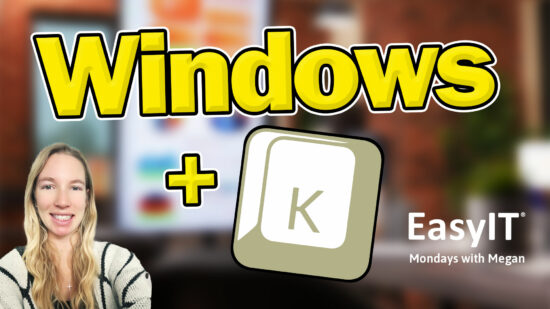Unlock Outlook’s Hidden Superpower: The Shortcut That Will Revolutionize Your Email Game
Are you drowning in a sea of emails? Struggling to keep your inbox organized? Get ready to supercharge your Microsoft Outlook experience with one simple yet incredibly powerful keyboard shortcut: CTRL + SHIFT + V!
This little-known combo is about to become your new best friend. But what does it do? Brace yourself for a productivity explosion:
CTRL + SHIFT + V instantly moves the email you’re reading into a folder of your choice!
Imagine the possibilities:
- Declutter your inbox in seconds
- Organize emails faster than ever before
- Achieve the elusive “Inbox Zero” with ease
Make your content more engaging by using compelling visuals and interactive elements. So, why not create a fun challenge for yourself? See how quickly you can sort 50 emails using this shortcut. Ready, set, organize!
Don’t let this game-changing trick slip through your fingers. Start using CTRL + SHIFT + V today and watch your email productivity soar to new heights!
Remember, in email management, you’re either ahead of the game or drowning in digital clutter. Which will you choose?
Key Takeaways
- Control + Shift + V opens the move-to-folder window in Outlook
- This shortcut speeds up email organization and inbox management
- Using keyboard shortcuts in Outlook can greatly improve productivity
Exploring the ‘Control + Shift + V’ Command in Outlook
The Control + Shift + V shortcut is a useful tool in Microsoft Outlook. It’s designed to paste text without formatting.
This command can save you time when copying content from other sources. Instead of pasting formatted text and removing the formatting, you can use this shortcut to paste plain text directly.
Unfortunately, Control + Shift + V doesn’t always work as expected in Outlook. Microsoft has changed how this shortcut functions in some versions of the software.
Control + Shift + V may not paste as plain text in newer Outlook versions. Instead, it might paste with the source formatting or do nothing.
If you find the shortcut isn’t working, try these alternatives:
- Use the Paste Special option
- Copy the text to Notepad first, then copy from Notepad to Outlook
- Use a third-party clipboard manager with a plain text-paste option
You can also set up a custom shortcut for pasting plain text in Outlook by using the Customize Keyboard feature in the Options menu.
Remember, keyboard shortcuts can vary between Outlook versions and operating systems. What works on one system might not work on another.

How to Use ‘Control + Shift + V’ in Microsoft Outlook
Outlook’s ‘Control + Shift + V’ shortcut lets you move messages quickly between folders. It’s a handy way to organize your inbox without using your mouse.
Selecting the Destination Folder
To use this shortcut, select one or more messages in your inbox. Press ‘Control + Shift + V’ on your keyboard. A new window will pop up showing your folder list.
Use the arrow keys to move up and down the list. To jump to a folder faster, type the first few letters of its name.
Press Enter when you’ve highlighted the right folder. Your selected messages will move there instantly.
Moving Messages Quickly
This shortcut saves time when sorting many emails. Before using ‘Control + Shift + V,’ you can select multiple messages at once.
To pick several messages in a row, click the first one. Then, hold Shift and click the last one. For messages that aren’t next to each other, hold Control as you click each one.
After moving messages, you’ll stay in your current view. This lets you keep working without losing your place.
Practice using this shortcut often. Soon, you’ll be able to sort your inbox faster.
Benefits of Keyboard Shortcuts in Email Management
Keyboard shortcuts can make your email tasks much faster and easier. They let you do everyday actions without taking your hands off the keyboard.
You can save time by using shortcuts to open, reply to, or delete emails quickly. This helps you get through your inbox more efficiently.
Shortcuts also reduce strain on your wrists and hands. You don’t need to switch between keyboard and mouse constantly.
Here are some helpful Outlook shortcuts:
- Ctrl + N: Create a new email
- Ctrl + R: Reply to the selected email
- Ctrl + F: Forward the selected email
- Ctrl + Enter: Send the open email
Using these can speed up your email workflow significantly. You’ll be able to process messages more quickly.
Keyboard shortcuts also work well for organizing your inbox. You can use them to:
- Move emails to folders
- Mark messages as read/unread
- Flag emails for follow-up
This makes it easier to keep your inbox tidy and find essential messages later.
Learning shortcuts takes some practice. But once you get used to them, they become second nature. You’ll wonder how you managed without them before.
Enhancing Productivity with ‘Control + Shift + V’
Control + Shift + V is a powerful keyboard shortcut that can speed up your work in Microsoft Outlook. It lets you paste text without formatting, saving time and keeping your emails neat.
Streamlining Workflow
Control + Shift + V helps you paste text quickly without messing up your email’s look. This shortcut strips away any bold, italics, or colors from the text you copy, so you don’t have to fiddle with formatting after pasting.
It’s great for mixing info from different sources into one email. You can grab text from a website, Word doc, or spreadsheet and paste it smoothly into your message. The text will match your email’s style right away.
This shortcut works in many other apps too. Use it in web browsers when filling out forms or writing social media posts. It keeps everything looking clean and consistent.
Reducing Reliance on the Mouse
Control + Shift + V can help you work faster by keeping your hands on the keyboard. You don’t need to reach for the mouse to click paste options or clear formatting.
Here’s how to use it:
- Copy text as usual (Control + C)
- Move to where you want to paste
- Press Control + Shift + V
This quick action saves seconds each time. Those seconds add up over a day of writing emails and reports.
You can also set up custom keyboard shortcuts in Outlook for other common tasks. This lets you do more without touching the mouse, speeding up your work even more.
Comparison with Other Outlook Movement Shortcuts
Ctrl+Shift+V is a powerful shortcut for moving items in Outlook, but it’s not the only one. Let’s compare it to other movement shortcuts.
Ctrl+Shift+V moves selected items to a folder you choose. This gives you full control over where items go.
In contrast, some shortcuts move items to preset locations:
- Ctrl+Shift+I moves messages to the Inbox
- Ctrl+Shift+O moves messages to the Outbox
These are faster if you frequently move items to those specific folders.
For navigating between Outlook sections, try these shortcuts:
- Ctrl+1 switches to Mail
- Ctrl+2 switches to Calendar
- Ctrl+3 switches to Contacts
- Ctrl+4 switches to Tasks
These let you quickly jump between different parts of Outlook.
When working with messages, you can use:
- Ctrl+R to reply
- Ctrl+F to forward
These shortcuts speed up everyday email actions.
Ctrl+Shift+V is more flexible than preset folder shortcuts. But it takes an extra step to select the destination folder. Choose the shortcut that best fits your workflow and the task at hand.
Troubleshooting Common Issues with ‘Control + Shift + V’
If you’re having trouble with the ‘Control + Shift + V’ shortcut in Microsoft Outlook, don’t worry. There are a few simple fixes you can try.
First, make sure you’re using the shortcut correctly. Press and hold Ctrl and Shift, then tap V.
If that doesn’t work, restart Outlook. Sometimes a simple reboot can solve the problem.
Still no luck? Try updating Outlook to the latest version. Microsoft often fixes bugs in new updates.
Another option is to check your keyboard settings. Make sure no other program is using this shortcut.
You can also try resetting Outlook’s ribbon and quick access toolbar. This might restore the shortcut functionality.
If none of these work, consider contacting Microsoft Support. They can provide more specific help for your situation.
Remember, ‘Control + Shift + V’ might not work in all parts of Outlook. It’s mainly for pasting plain text in email messages.
This shortcut may have different functions in Word and Excel. In Word, you’ll need to use the ribbon menu to paste without formatting instead.
Customizing Shortcut Keys in Outlook
You can change Outlook’s keyboard shortcuts to suit your needs, which allows you to work faster and more efficiently.
To customize shortcuts, go to File > Options > Customize Ribbon. At the bottom, click “Customize” next to “Keyboard shortcuts”.
In the new window, select a category from the left. Then, select the command you want to change on the right.
Click in the “Press new shortcut key” box. Type the key combo you want to use. If it’s already taken, you’ll see a warning.
Click “Assign” to set your new shortcut. You can remove old ones by selecting them and clicking “Remove”.
Remember to test your changes. Make sure they don’t conflict with other shortcuts you use often.
If needed, you can reset all shortcuts to their defaults. Just click the “Reset All” button at the bottom of the window.
Customizing shortcuts takes time, but it’s worth it. In the long run, you’ll save many clicks and keystrokes.
Best Practices for Keyboard Shortcut Usage in Outlook
Learn a few shortcuts at a time. Don’t try to memorize them all at once. Start with the ones you use most often.
Practice regularly. The more you use shortcuts, the faster they’ll become second nature.
Make a cheat sheet. Keep a list of your favorite shortcuts handy until you’ve memorized them.
Use the Ctrl key for everyday actions. Many Outlook shortcuts use Ctrl, like Ctrl+N for a new message.
Try combination shortcuts. Some actions use multiple keys, like Ctrl+Shift+V to move an item.
Customize shortcuts to fit your needs. Outlook lets you create custom keyboard shortcuts for frequently used actions.
Take advantage of universal Windows shortcuts. Many work in Outlook, too, like Ctrl+C for copying and Ctrl+V for pasting.
Use Alt+letter combos to access menu items quickly. These shortcuts are shown as underlined letters in menu names.
Remember that some shortcuts may vary depending on the Outlook version. If a shortcut doesn’t work as expected, check your specific version.
Don’t forget about function keys. F7 checks spelling, while F9 sends/receives all folders.





